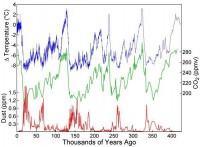Gregory F. Fegel, Pravda, January 11, 2009
The earth is now on the brink of entering another Ice Age, according to a large and compelling body of evidence from within the field of climate science. Many sources of data which provide our knowledge base of long-term climate change indicate that the warm, twelve thousand year-long Holocene period will rather soon be coming to an end, and then the earth will return to Ice Age conditions for the next 100,000 years.
Ice cores, ocean sediment cores, the geologic record, and studies of ancient plant and animal populations all demonstrate a regular cyclic pattern of Ice Age glacial maximums which each last about 100,000 years, separated by intervening warm interglacials, each lasting about 12,000 years.
Most of the long-term climate data collected from various sources also shows a strong correlation with the three astronomical cycles which are together known as the Milankovich cycles. The three Milankovich cycles include the tilt of the earth, which varies over a 41,000 year period; the shape of the earth’s orbit, which changes over a period of 100,000 years; and the Precession of the Equinoxes, also known as the earth’s ‘wobble’, which gradually rotates the direction of the earth’s axis over a period of 26,000 years. According to the Milankovich theory of Ice Age causation, these three astronomical cycles, each of which effects the amount of solar radiation which reaches the earth, act together to produce the cycle of cold Ice Age maximums and warm interglacials.
The graph of the Vostok ice core data <> shows that the Ice Age maximums and the warm interglacials occur within a regular cyclic pattern, the graph-line of which is similar to the rhythm of a heartbeat on an electrocardiogram tracing. The Vostok data graph also shows that changes in global CO2 levels lag behind global temperature changes by about eight hundred years. What that indicates is that global temperatures precede or cause global CO2 changes, and not the reverse.

In other words, increasing atmospheric CO2 is not causing global temperature to rise; instead the natural cyclic increase in global temperature is causing global CO2 to rise. The reason that global CO2 levels rise and fall in response to the global temperature is because cold water is capable of retaining more CO2 than warm water. That is why carbonated beverages loose their carbonation, or CO2, when stored in a warm environment. We store our carbonated soft drinks, wine, and beer in a cool place to prevent them from loosing their ‘fizz’, which is a feature of their carbonation, or CO2 content. The earth is currently warming as a result of the natural Ice Age cycle, and as the oceans get warmer, they release increasing amounts of CO2 into the atmosphere.
About 325,000 years ago, at the peak of a warm interglacial, global temperature and CO2 levels were higher than they are today. Today we are again at the peak, and near to the end, of a warm interglacial, and the earth is now due to enter the next Ice Age. If we are lucky, we may have a few years to prepare for it. The Ice Age will return, as it always has, in its regular and natural cycle, with or without any influence from the effects of AGW.
The AGW theory is based on data that is drawn from a ridiculously narrow span of time and it demonstrates a wanton disregard for the ‘big picture’ of long-term climate change. The data from paleoclimatology, including ice cores, sea sediments, geology, paleobotany and zoology, indicate that we are on the verge of entering another Ice Age, and the data also shows that severe and lasting climate change can occur within only a few years. While concern over the dubious threat of Anthropogenic Global Warming continues to distract the attention of people throughout the world, the very real threat of the approaching and inevitable Ice Age, which will render large parts of the Northern Hemisphere uninhabitable, is being foolishly ignored. See more here.
Earlier last week, Joe Bastardi had speculated that Putin was aware of the global cooling threat. See Noel Sheppard’s take on this Pravda story here. As Alan Siddons notes Whether most of the “new carbon dioxide” we’ve been seeing these past few decades owes to the recent Little Ice Age rebound or even to a delayed effect from the Medieval Warm Period - who knows? - it is certainly not due to human emissions. Because most of this extra CO2 doesn’t have the correct isotope signature.”


